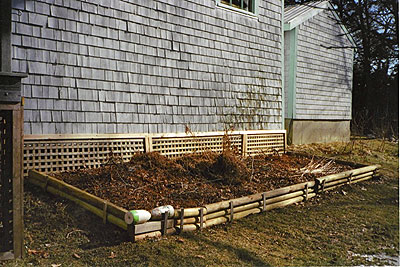 |
| This low garden bed was made with leaves, twigs, tree branches and compost – similar to a hugelkultur bed but lower, and without very large logs. Bobbie Goodell photo. |
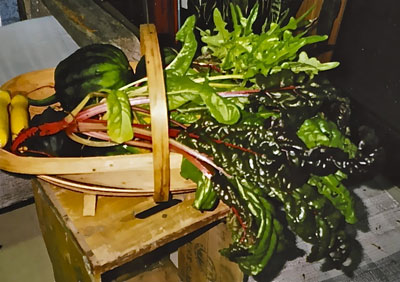 |
| Produce from the garden bed. Bobbie Goodell photo. |
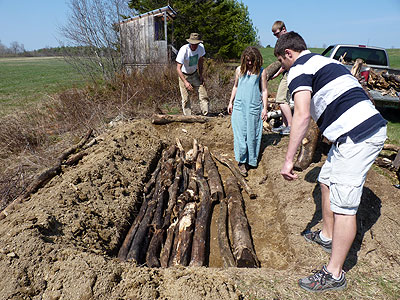 |
| Hugelkultur mounds can be higher – like this one made by Jack Kertesz of MOFGA and Unity College students. Many are even higher and are made with even larger logs. English photos. |
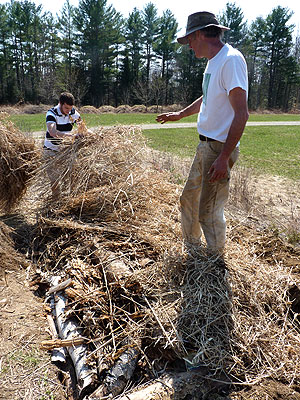 |
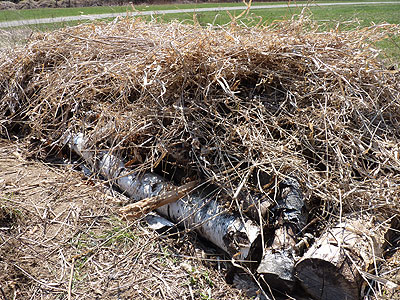 |
By Bobbie Goodell
When I moved to my lovely old Maine house more than two years ago, I was attracted by the variety of ornamental shrubs and plants and impressed by the several tall old oaks and some younger pines surrounding it. But it was October, the leaves were mostly off the trees, and the south-facing backyard was sunny.
Come next spring and summer – where was the sunny space? What to do with all the branches, twigs and leaves from those nice trees? I was still busy settling in to my new home, so my outside activities were mostly confined to trying to keep the sloping lawn mowed and to resting on the nice deck.
That fall at the Common Ground Country Fair, I heard about hugelkultur and saw a demonstration mound that Jack Kertesz had built there from leg-sized logs, branches, corn stalks and other available organic matter.
Hugelkultur can be translated from the German as “mound culture.” It involves piling plant material – including woody branches and large tree trunks – in a mound, covering the mound with planting media (compost, topsoil …) and planting on the mound. Hugelkultur is a handy way to garden where soils are compacted, poorly drained, and/or when materials to make a mound are available. The rotting logs act like sponges, soaking up soil water and making it available to plants over long periods of time. For details, see www.richsoil.com/hugelkultur/.
Kertesz describes his first pile at Common Ground as “hugel-lite.” Another mound he created, with help from Unity College students, had a base of rotting logs from a nearby forest, set in a dug-out rectangular bed, covered with old hay, and left to settle and rot. This is closer to a bona-fide hugelkultur mound, which thrives due to the moist, spongy, rotting logs – a long-term savings bank of carbon and water made from materials that are abundant in forests.
“Great idea” I thought, “but the Common Ground site has all that nice sun and flat land.”
Back home I looked out at the lawn and wondered: south-facing – good; lots of big trees, 15 percent (guessing) grade, patches of shrubs, small trees, perennial plants – not so good. If I want a vegetable garden, what to do?
I’ve always made a vegetable garden at places I’ve owned, even if it meant digging up maple roots or sifting small rocks from soil. It was fun to grow kohlrabi for the first time and have neighbors worried about the “tumors” on my vegetables that might spread to other gardens. I even grew a small crop of peanuts in southern Ohio, and folks were amazed to see them dug up from underground.
My Maine garden would need to back up against an existing building foundation and its lattice covering, so I enveloped the 10- by 20-foot space with timbers on three sides. Then the fun of cleaning the yard and filling the space began. To create my garden bed, I used a combination of a sheet mulching technique (laying mulching materials directly on the sod) and hugelkultur. Leaves, twigs, small tree branches broken up as much as I could, some larger tree branches and unfinished compost – all went in. I marked narrow paths with sticks so that I wouldn’t walk on seeded areas.
As I planted, bigger seeds – cucumber, squash, etc. – posed little problem, but small seeds, such as lettuce, fell so far into the material that I doubted they would germinate well, if at all. So I spread some topsoil where the smaller seeds were to go.
I was a bit unnerved at first to explain to visitors what the pile of yard rakings was doing against the building – I had left a small lilac and some hostas growing there – but as the seeds sprouted and began to grow, less explanation was needed. I was excited to see what was making its way up through the rough stuff.
Unfortunately I wasn’t the only one interested! The loose bedding also tempted small varmints to scratch and dig, so I had to replant or settle some new sprouts. But overall I was delighted to see what did begin to grow, and even flourish, in the rather shaded, sloping, rough bed, including lettuce, chard, summer and acorn squash. Root crops – beets and carrots – did not do well, as might be expected. Climbing beans were virtually decimated by – squirrels? Also, I didn’t use enough supporting material. Tomatoes had too little space and sun.
Still, what a treat to grow food mostly out of what would have been put in the compost pile! Working in close spaces and on a slope was tricky. I couldn’t stride down along the rows of beans as I could have with a flat bed in a field. Tools, baskets, etc., all had to be fetched from outside the garden itself. And I lost count of how many times the surrounding timbers and stakes were kicked, backed into, even knocked down.
Was it worth it? You bet. I may now be confident enough to move the hostas and lilac so that I can make a better “hugel” and start “kultur”-ing it.
About the author: Bobbie grew up in Massachusetts, nibbling as a child on the corn, peas and carrots she was asked to bring in from the garden for supper. Now she gardens in South Thomaston.
Ed. note: I also had a gardening situation that benefited from a hybrid hay bale-hugelkultur-style solution. One bed at the south end of my slightly sloped garden tended to erode and needed a nutritional boost. I lined it with a rectangle of hay bales and filled the interior with apple tree and raspberry cane prunings, including some large branches, and more-herbaceous compostables, topped with a layer of partially decomposed compost. I added a layer of hay and planted potatoes and sunflower transplants in that layer of hay. They did great. Now, a year later, the mound is lower, much decomposed, and I’ll plant squash in it.

